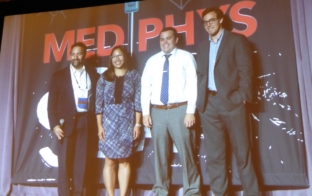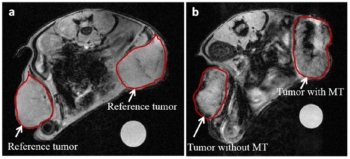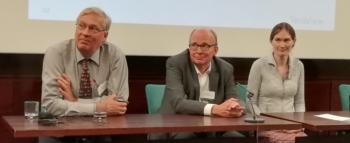Flash Physics is our daily pick of the latest need-to-know developments from the global physics community selected by Physics World's team of editors and reporters
Bevelled edges confound topological protection
The much vaunted protection from backscattering afforded by topological materials could be diminished by the real-world effects. That is the conclusion of Jianhui Wang and Yigal Meir of Ben-Gurion University and Yuval Gefen of the Weizmann Institute of Science in Israel, who have calculated how bevelled edges affect the flow of electrons in a quantum spin-Hall phase 2D topological insulator. Electrons in one spin state will only flow clockwise around the edges of such a material, while electrons in the opposite spin state will only flow anticlockwise. For an electron to backscatter from a defect in its path and flow in the opposite direction, it must flip the direction of its spin. However, spin flips are forbidden by symmetry considerations and therefore electrical currents flowing around the edge of the material are “topologically protected” from backscattering. This protection means that such materials have very high electron mobility and could be used to create high-speed electronic devices. In practice, however, 2D topological insulators have a finite thickness and this means that the edges could be bevelled rather than abrupt. Wang, Meir and Gefen looked at what happens when the electrical potential of the atomic lattice drops off at the edge of a topological insulator. When the drop-off is gradual, they found that electrons in a specific spin state can flow in both directions – which means that backscattering is possible. Writing in Physical Review Letters, the researchers say: “This calculation underpins the fragility of the topological protection in realistic systems, which is of crucial importance in proposed applications.”
Societies call on Trump to rescind visa ban
More than 150 scientific societies and institutions, including the American Physical Society and the American Institute of Physics, have published an open letter calling on US president Donald Trump to reverse his 27 January executive order on visas and immigration. Last week, Trump signed an order that suspends the US Refugee Admissions Programme by 120 days with anyone arriving in the US from seven Muslim-majority countries – Iraq, Syria, Iran, Libya, Somalia, Sudan and Yemen – facing a 90 day visa ban. Drafted by the American Association for the Advancement of Science, the letter says that the order will “have a negative impact on the ability of scientists and engineers in industry and academia to enter, leave from and return to, the United States”, adding that the move will “discourage many of the best and brightest international students, scholars, engineers and scientists from studying and working in the United States”. The societies add that they are ready to assist the administration with formulating an immigration and visa policy.
- You can find all our daily Flash Physics posts in the website’s news section, as well as on Twitter and Facebook using #FlashPhysics.




